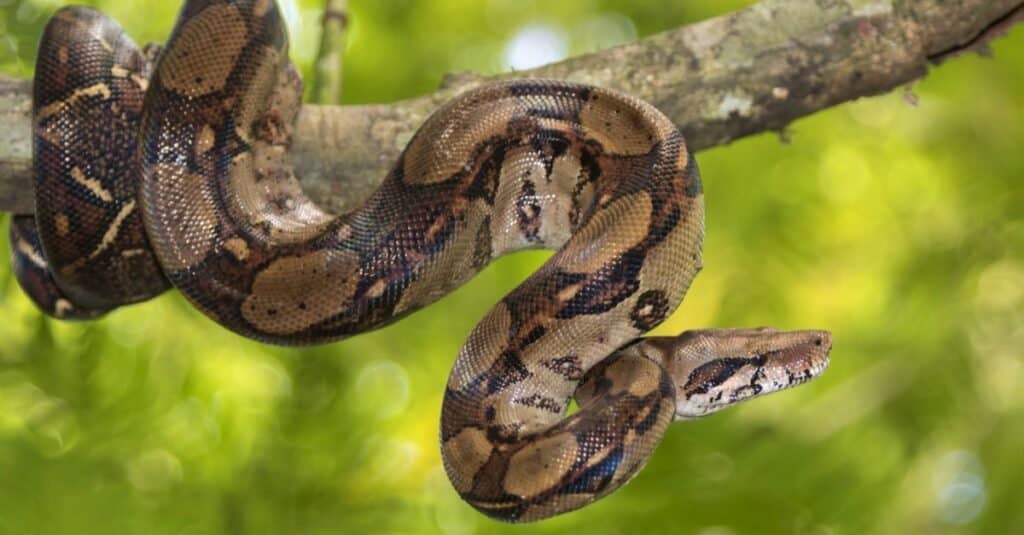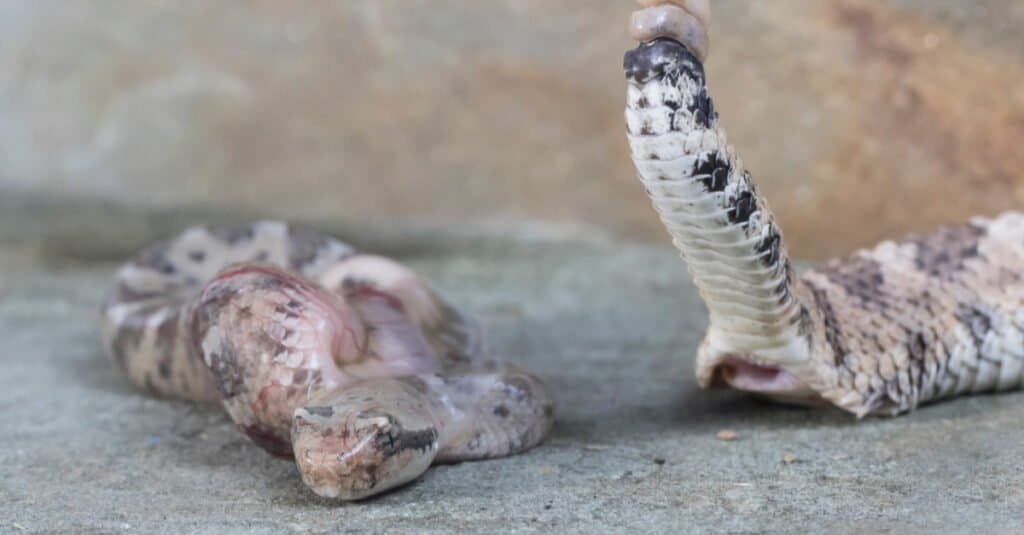
The post The Fascinating Life Cycle of Snakes appeared first on A-Z Animals.
Snakes are found on every continent except for Antarctica and can occupy a wide range of habitats, including forests, deserts, grasslands, and aquatic habitats in both rivers and seas. This diverse group of reptiles reproduces in several different ways and grows by shedding their skin. Let’s dive into the fascinating subject of snake life cycles.
Different Types of Snake Reproduction
Female snakes can produce their offspring in several different ways. Many people assume that all snakes lay eggs, but the true situation is more complex than this. The different types of snake reproduction are oviparous, viviparous, ovoviviparous, and parthenogenesis. We still don’t have a definitive reason why each snake species uses a particular method, but it is thought that environmental factors such as temperature and availability of suitable nesting sites play a role.
Oviparous Reproduction

Some snakes lay leathery eggs.
©Ken Griffiths/Shutterstock.com
Oviparity is a reproductive strategy where the female snake lays eggs, and this is typically in a safe location such as a nest, an underground burrow, or hidden in leaf litter.
Oviparity gives snakes a few advantages: they can produce multiple eggs at once, and the parents do not need to provide much parental care. As a result, the energy required to produce offspring is quite low. Around 70 percent of snake species are oviparous, and this includes pythons and cornsnakes.
Size of Clutch and Incubation Period
Most snakes lay their eggs and then leave, so the baby snakes have to fend for themselves when they hatch. However, there are some exceptions. The female king cobra pushes branches and leaves into a pile and lays her eggs on them. As the vegetation decomposes, it raises the temperature and helps to incubate them. She also lies on top of her nest, and the male remains close by. Both aggressively defend their brood from potential predators.
Incubation periods vary by species from tens of days to a few months. Ball python (Python regius)eggs need to be incubated for around two months, for example. The Eastern hognose snake (Heterodon platirhinos)has an incubation period of around 56 days. Often, the incubation will be quicker if the nest and ambient temperature are warmer.
The size of the clutch also varies. The Barbados threadsnake (Tetracheilostoma carlae)lays just one egg, whereas the Burmese python (Python bivittatus) can lay 96 eggs in one go!
About Amniotic Eggs
Oviparous snakes lay amniotic eggs, which are eggs with a shell and a series of special membranes that conserve moisture. At the center of the egg is the embryo protected by the inner layer called the amniotic membrane, filled with amniotic fluid. This provides the embryo with a stable environment within which to grow and develop. The next membrane, the allantois, provides gas diffusion and allows waste to be removed. There is a yolk sac, which provides nutrition and gets smaller as the embryo uses up the food and develops. The final membrane is the chorion, which surrounds all the other structures. In between the chorion and the outer shell, there is the egg albumen. This serves a number of different functions, including as a water reservoir, a protein source, and protection from mechanical stress and pathogens. Finally, the outer shell protects the whole egg and prevents it from drying out while also allowing air to diffuse to the embryo.
Why Are Snake Eggs Leathery?
Bird’s (avian) eggshells are called calcareous, and they are brittle and hard. We all know how easy it is to break an avian eggshell. Snake eggs, in contrast, are leathery, tough, and flexible. This means that they can withstand colliding with each other as they are laid in holes, and abrasion is reduced when they are laid in sand. Snake egg shells are remarkably deformable and tough. This is down to a wavy and random arrangement of keratin fibers and to collagen layers.
Viviparous Reproduction

Boa constrictors give birth to live young.
©Natalia Kuzmina/Shutterstock.com
Some snakes give birth to live young, and this is called viviparity. Viviparous females nourish their young internally in a similar way to mammals. The maternal component of the placenta is the lining of the uterine oviduct. Then, they give birth to a litter of baby snakes. True viviparity is rare in snakes, but a leading example is the boa constrictor (Boa constrictor), in which maternal investment is considerable. Gestation lasts for between five and eight months, and litters can contain between 10 and 64 little snakes.
Ovoviviparous Reproduction
Ovoviviparity is more common than viviparity. Here, the eggs develop inside the female’s body, allowing for the young to hatch internally before being born. It therefore offers a form of live birth without direct maternal nourishment during development. Many aquatic snakes are ovoviviparous, as are snakes that are more capable of defending their young. This includes large snakes and venomous snakes. Essentially, this means that the young snakes are safer inside the mother than outside in an egg. Also, ovoviviparity is seen more often in cooler climates where the eggs would not reach a high enough temperature to develop.
The Western diamondback rattlesnake (Crotalus atrox), for example, has a gestation period of 167 days and gives birth to between 10 and 20 young. The birthing process takes between three and five hours.
The yellowbelly sea snake (Pelamis platura)has a gestation period of around five or six months and gives birth to between one and 10 young.
Parthenogenesis
Parthenogenesis is a further type of reproduction in snakes where the female can produce offspring without needing a male. This was once thought rare but has now been recorded more frequently. In facultative parthenogenesis, the female can swap back and forth between sexual reproduction, where she needs to mate, and asexual where she does not.
Facultative parthenogenesis has been seen in king cobras, some species of pit vipers, and in a pet ball python. As the female produces her egg cells (gametes), fusion takes place to produce a whole new individual. It enables lone female snakes to colonize new habitats, but there may be other reasons for its use.
Obligate pathenogenesis is when the female can only reproduce asexually. This has only been confirmed in the blind snake (Indotyphlops braminus).
What Are Newborn Snakes Called?

Rattlesnake snakelets are born and don’t hatch from eggs.
©Mark_Kostich/Shutterstock.com
Newborn snakes are either born by the mother’s body or emerge from their eggs. In this early stage of their life, they are called snakelets. They instinctively seek out food, warmth, and shelter. These small snakes are very vulnerable to predators, so their coloration may differ from that of adult snakes to provide better camouflage.
Many snakelets also shed their first skin within a few days of hatching or being born. This is a process that will continue throughout the snake’s life, but younger snakes shed more frequently than older ones. This is a period of rapid change and development. The snakelets may switch habitats and develop hunting skills. This is called the juvenile stage.
Reaching Sexual Maturity
When the snake has the physical and physiological capability for breeding, it is termed sexually mature. The exact age of sexual maturity is governed by a combination of genetics (species), size, environmental conditions, and health.
For example, female garter snakes reach sexual maturity at three years of age, but males are sexually mature at one or two years old. In the smooth green snake (Opheodrys vernalis), however, both males and females reach sexual maturity at two years of age.
Mating
When female snakes are ready to mate, they leave a pheromone trail for the male to follow. He then usually initiates courtship, and after some initial rubbing, he will wrap his tail around her to align their cloacas (opening used for both mating and excretion). The sperm is transferred into the female, but it can be stored for months before it is actually used for fertilization. In some species, such as the anaconda, several males try to mate with a female at the same time, creating a ‘mating ball’.
The post The Fascinating Life Cycle of Snakes appeared first on A-Z Animals.
November 24, 2025 at 06:32PMSharon Parry
.jpeg)
.jpeg)

0 Comments